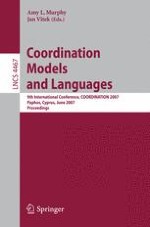2007 | Buch
Coordination Models and Languages
9th International Conference, COORDINATION 2007, Paphos, Cyprus, June 6-8, 2007. Proceedings
herausgegeben von: Amy L. Murphy, Jan Vitek
Verlag: Springer Berlin Heidelberg
Buchreihe : Lecture Notes in Computer Science
